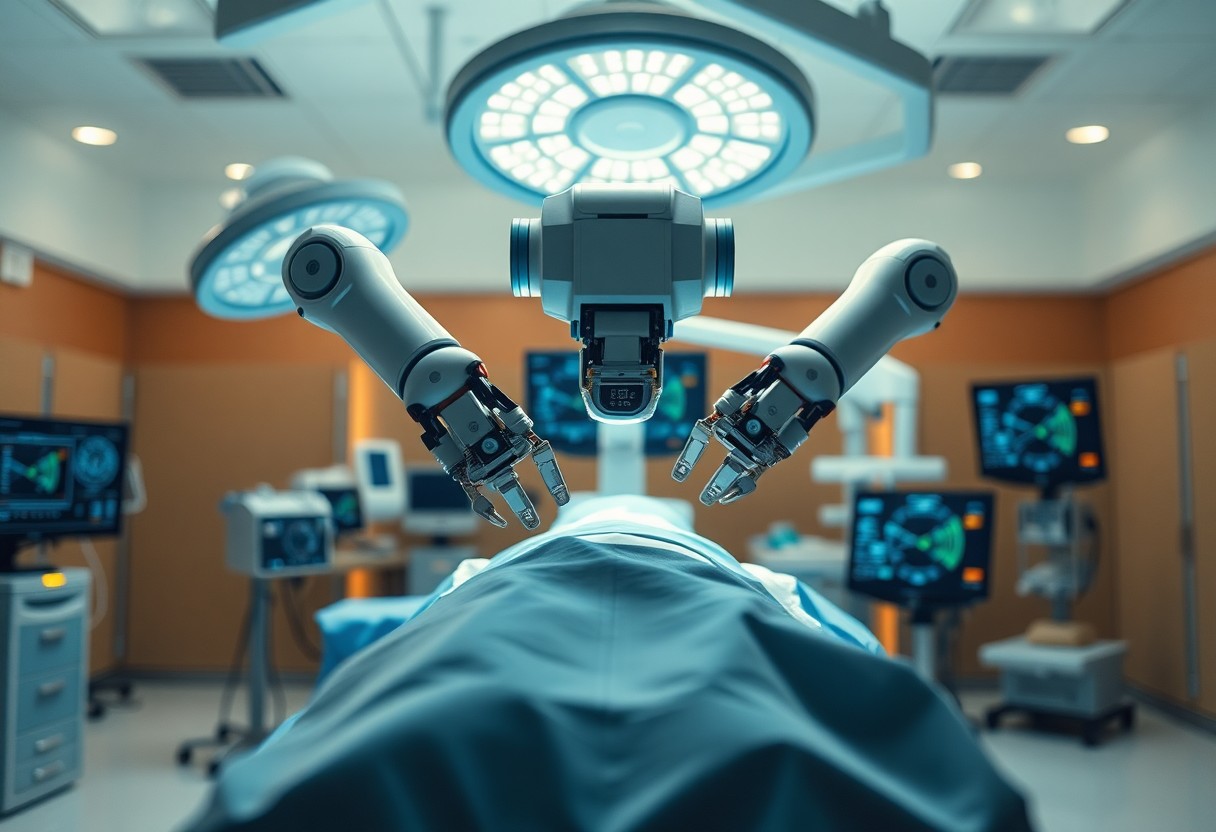Most modern surgical practices now integrate robotic technology, enhancing the precision and effectiveness of minimally invasive procedures. You’ll find that these advanced systems allow for smaller incisions, reduced recovery times, and improved outcomes in various surgical fields. By understanding how robots assist surgeons, you can appreciate the revolutionary impact this technology has on patient care and the future of medicine.

Overview of Surgical Robotics
Surgical robotics has transformed the landscape of operating rooms, allowing for minimally invasive procedures that enhance recovery times and precision. You benefit from the improved dexterity and control offered by robotic systems, which are designed to assist surgeons rather than replace them. This technology enables complex surgeries to be performed with smaller incisions, leading to less trauma and shorter hospital stays.
Types of Surgical Robots
Several types of surgical robots are utilized today, each tailored to specific procedures. You might encounter systems like robotic arms, tele-operated robots, and collaborative robots, each serving unique functions.
- Robotic arms for precise movements
- Tele-operated robots for remote surgeries
- Collaborative robots for aid in manual tasks
- Robotics in laparoscopic procedures
- Additional systems customized for specific specialties
Any of these robotic systems enhances surgical capabilities.
| Type | Description |
| Robotic Arms | Provide precision control for surgeons |
| Tele-operated Robots | Allow remote surgery via communication technology |
| Collaborative Robots | Simplify manual tasks in surgery |
| Laparoscopic Robots | Facilitate minimally invasive procedures |
| Specialty Robots | Customized for specific surgical specialties |
Evolution of Robotics in Surgery
The evolution of robotics in surgery has shown remarkable advancements since the introduction of the first surgical robot, the PUMA 560, in 1985. Over the decades, technology has progressed significantly, leading to the development of systems like the da Vinci Surgical System, which has performed millions of procedures globally. You see the integration of imaging and artificial intelligence, enhancing the precision and effectiveness of robotic-assisted surgeries.
The journey of surgical robotics began with basic systems designed for simple tasks but rapidly transitioned into sophisticated platforms capable of performing complex procedures. For example, the da Vinci system utilizes high-definition 3D visualization and instruments that mimic the movements of the human hand but with greater dexterity. Other advancements include robotic systems that integrate augmented reality to improve surgical accuracy and decision-making. As technology continues to evolve, you can expect even more innovations, driving benefits in surgical practice efficiency and patient outcomes.
Benefits of Robotic-Assisted Surgery
Robotic-assisted surgery offers numerous advantages, significantly improving patient outcomes. With enhanced precision and reduced trauma, procedures become less invasive, translating into shorter hospital stays and quicker recoveries. Studies indicate that robotic surgeries often result in decreased blood loss and lower complication rates, making them a safer alternative for many patients. For a deeper understanding, explore Robotic Surgery: A Comprehensive Review ….
Enhanced Precision and Control
Your surgical outcomes can greatly benefit from the enhanced precision and control provided by robotic systems. These innovative tools offer surgeons a magnified, 3D view of the surgical site, allowing for meticulous movements that traditional techniques cannot achieve. As robotic arms mimic the surgeon’s hand movements, they reduce hand tremors and fatigue, enabling more complex procedures to be performed with confidence.
Reduced Recovery Time
Recovery times significantly decrease with robotic-assisted surgery, which is particularly advantageous for your overall health and well-being. Less invasive techniques lead to smaller incisions and minimized tissue damage, thus promoting faster healing. Patients commonly experience shorter hospital stays, with many returning to their daily activities in a fraction of the time compared to traditional surgical methods.
For example, studies show that patients undergoing robotic prostatectomies often leave the hospital within one to two days, as opposed to five or more days for open surgeries. This quick transition back to normal life not only enhances physical health but also sparks a faster return to work and leisure activities. Overall, robotic-assisted surgeries are becoming vital tools in optimizing recovery and improving long-term outcomes for you.
Minimally Invasive Techniques
Minimally invasive techniques reduce trauma to the body, resulting in less pain and faster recovery for you. These approaches often involve small incisions, which contribute to decreased scarring and shorter hospital stays. Advanced imaging and robotics enhance precision, allowing for complex procedures without the need for large incisions that traditional methods require.
Comparison with Traditional Surgery
Your experience with minimally invasive surgery can differ significantly from traditional methods. Here’s a breakdown of key differences:
| Traditional Surgery | Minimally Invasive Surgery |
| Large incisions | Small incisions |
| Longer recovery time | Faster recovery |
| More pain and scarring | Less pain and reduced scarring |
| Longer hospital stays | Shorter hospital stays |
Applications in Various Specialties
Minimally invasive techniques are increasingly applied across multiple medical specialties, advancing surgical practices and enhancing outcomes. From urology to gynecology, these techniques have allowed you to benefit from reduced risks and improved recovery timelines.
In urology, robotic-assisted laparoscopic prostatectomies demonstrate the efficacy of minimally invasive approaches, leading to decreased complications and improved urinary function post-surgery. Gynecology utilizes laparoscopy for procedures like hysterectomies and fibroid removals, significantly lowering recovery times. Additionally, orthopedic surgeries, such as knee arthroscopies, showcase the advantages of smaller incisions, translating into quicker rehabilitation for patients. These examples illustrate how diverse medical fields benefit from incorporating minimally invasive techniques, providing you with safer and more efficient surgical options.
Challenges and Limitations
Robotic surgery, despite its advancements, faces notable challenges and limitations that impact its widespread adoption. Issues such as high costs, technical restrictions, and the steep learning curve for surgeons can influence the effectiveness and accessibility of robotic systems in clinical practice. Additionally, the reliance on advanced technology can raise concerns about patient safety and efficacy when not properly managed.
Cost and Accessibility
The financial investment associated with robotic surgical systems is significant, often ranging from $1 million to over $2 million. This high cost can limit accessibility for smaller hospitals and surgical centers, making it difficult for some patients to receive robotic-assisted procedures. Consequently, the disparity in availability may lead to unequal healthcare outcomes across different regions.
Technical Limitations and Learning Curve
Robotic systems, while sophisticated, have inherent technical limitations, including lack of haptic feedback and potential for mechanical failure. Surgeons must navigate a steep learning curve, as proficiency in robotic surgery often takes years to achieve. Inadequate training can compromise surgical outcomes, as surgeons may struggle to adapt to the nuances of robotic instrumentation versus traditional methods.
Training for robotic surgery requires extensive hands-on experience, often supplemented by simulation technology. Many surgical programs emphasize mentorship and supervised practice, yet discrepancies exist in the quality and range of training offered. Furthermore, mastering techniques such as robotic suturing and tissue manipulation is vital, as even minor discrepancies can lead to complications. Surgeons must engage in continuous learning to keep up with evolving technology and maintain high standards of patient care.
Future Trends in Surgical Robotics
Advancements in surgical robotics suggest a promising future, with technologies continuously evolving to enhance precision and efficiency in operations. You can expect smaller, more adaptable robots capable of performing complex procedures with even greater accuracy. As integration with augmented reality becomes more widespread, visual guidance during surgeries may significantly improve the outcomes. Additionally, miniaturization trends hint at the potential for robotic platforms to operate within confined spaces, broadening the scope of minimally invasive surgeries.
Innovations on the Horizon
Emerging innovations are set to redefine surgical robotics, paving the way for smart assistance systems that can analyze real-time data during procedures. You are likely to see enhancements in the dexterity and responsiveness of robotic arms, along with the development of advanced haptic feedback systems. These innovations will enable surgeons to enhance their skillsets and transform traditional surgical methods into more efficient practices.
Impact of AI and Machine Learning
AI and machine learning are poised to revolutionize surgical robotics, enabling systems to learn from previous procedures. With vast amounts of surgical data, these technologies can identify patterns and suggest optimal techniques tailored to individual patients, which can enhance precision and reduce risks. As AI algorithms evolve, you might witness robots that adjust in real-time, making split-second decisions that further aid in minimally invasive surgeries.
AI’s integration into surgical robotics is already starting to show significant results. For instance, systems like the da Vinci Surgical System leverage machine learning algorithms to enhance the accuracy of incision placement and instrument movement. In trials, AI-assisted robotic surgeries have shown a reduction in complications by up to 30%. As more data accumulates, the continual refinement of these algorithms will lead to smarter, more intuitive robots capable of assisting in complex procedures. This could not only improve patient outcomes but also streamline surgical workflows, further solidifying the role of robotic assistance in the operating room.
Ethical Considerations
The integration of robotic systems in surgery raises several ethical questions that require careful consideration. You may find yourself evaluating the implications of robotic intervention on patient trust, including concerns over the potential for machine error and the displacement of human skills. As robotic surgeries become more prevalent, engaging in discussions about these ethical dilemmas is imperative for ensuring the responsible development and application of these technologies.
Patient Safety and Accountability
Patient safety remains a top priority in robotic surgery, yet accountability becomes complex when machines are involved. You should understand that while robots enhance precision, determining liability in the event of complications can be challenging. This ambiguity necessitates clear guidelines to ensure that healthcare providers remain responsible, especially when robotics are a significant part of the surgical process.
Informed Consent
Informed consent plays a critical role in robotic surgeries, impacting how patients perceive and accept the technology. You ought to be aware that clear communication regarding the risks and benefits of robotic intervention is necessary for obtaining genuine consent. Comprehensive discussions help establish trust and ensure that patients make knowledgeable decisions about their treatment options.
Informed consent should encompass a thorough explanation of the surgical procedure, including potential risks specific to robotic systems, such as mechanical failures or limitations in technology. You may be informed about the differences between traditional surgery and robotic-assisted techniques, allowing you to assess the likelihood of improved outcomes or complications. Furthermore, discussing alternative options empowers patients to weigh the pros and cons, ultimately leading to decisions that align with their personal values and preferences.
Final Words
Summing up, as you consider the future of healthcare, robots in surgery and minimally invasive operations present significant advancements that enhance precision and reduce recovery time. You can anticipate a shift towards more personalized and effective treatments, as these technologies continue to evolve. By integrating robotics into surgical procedures, your healthcare experience can become less invasive, leading to improved outcomes and faster recuperation. Embracing these innovations means being at the forefront of a transformative era in medicine.







